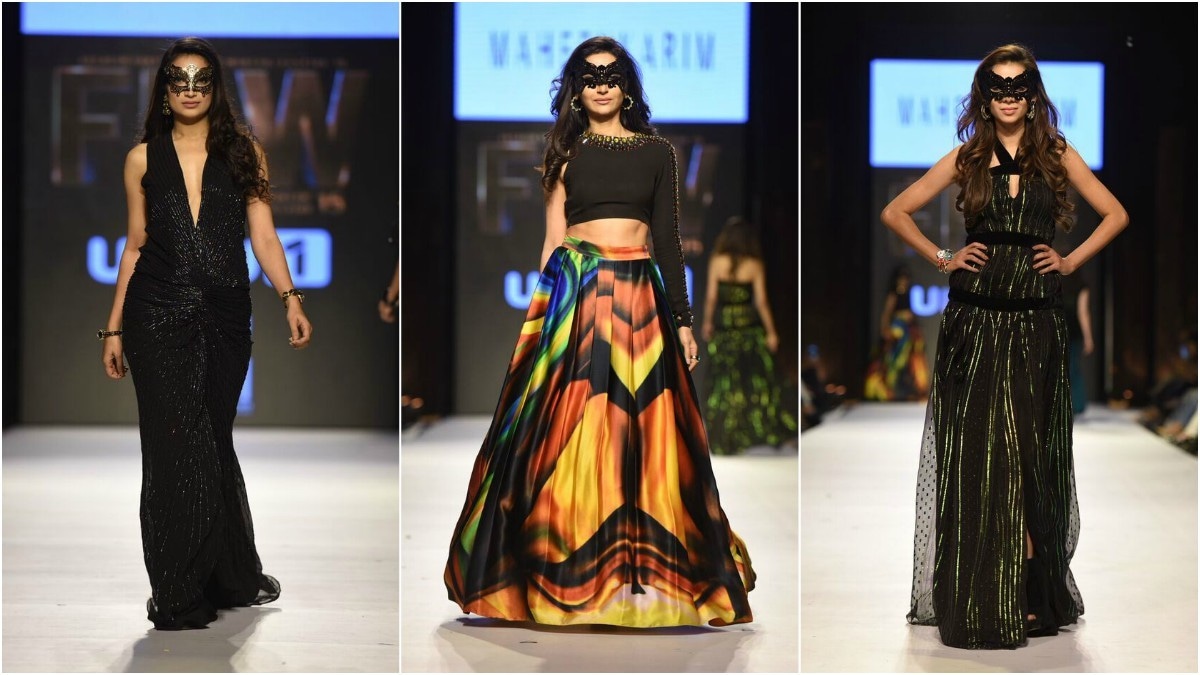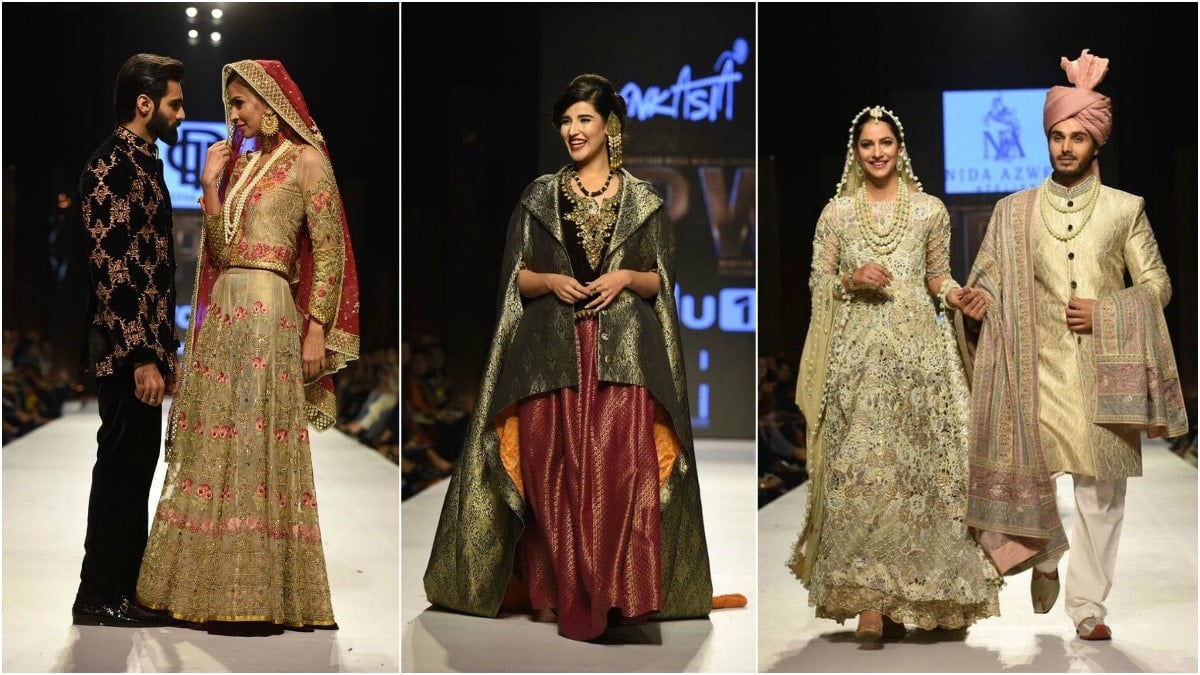Fashion, feminism and futility
Fashion Pakistan Week (not to be confused with Pakistan Fashion Week) was held recently with the usual fanfare that surrounds such undertakings; there were ‘red carpets’, there were live tweets, there were catwalks and models and glitz and glamour. Fashion houses, several of them led by the sisters, wives and daughters of this or that industrial tycoon, presented their ‘collections’; everyone beamed and glowed and was feted.
There were French words like ‘prêt’ to add hauteur to the couture, routine allusions to the Raj to impart to the rest the sumptuousness of eras past. In sum, it was new, but all very old; an event dominated by women, but one that did nothing for them beyond reiterating their already accepted status as decorative playthings.
Also read: FPW Day1: Shehla Chatoor and Sania Maskatiya win big, other collections fall short
Fashion week or events around fashion are complicated things in Pakistan; the heavy and hefty shadow of bombs and threats and terror has cast its shadow to such an extent over cultural production in the country that any effort, however replete with sexism and elitism, seems to require applause. It is not entirely undeserved; the obscurantism mandating that women not be visible at all is in a very basic sense opposed by events that make them visible and central.

These, then, have been the parameters of the debate: women visible must be women resistant and even women strong and independent. This last part is where the problem lies, for while terror’s incursions create the basic opposition, the refusal to further analyse, critique or dissect what occurs in opposition suggests in itself a capitulation to terror’s binary and basic us-and-them divisions. If Pakistan can have a fashion scene, it can also have a feminist critique.
In the Pakistani context, some of fashion's diminution lies in the reality that those who dictate, even create, fashion are entirely the wealthy, who may not necessarily be talented. Fashion hence is reduced and stunted, unable to speak
In her book Fresh Lipstick: Redressing Fashion and Feminism, Linda Scott writes “the ability to control what is fashionable is the power women wield over each other”. In this sense, a fashion week, with designers, buyers, watchers, tweeters, bloggers, models, photographers and telecasters, promotes a certain notion of women’s place in society. In Pakistani culture, this place has always focused on women as beautified objects, and in this sense the elevation of fashion, the industry surrounding it, pushes a notion and an idea that most are comfortable with and identify with without much discomfort.
Also Read: FPW Day 2: Elan and Wardha Saleem rule the night by staying true to their ethos
To keep things interesting, proportions of revealed and obscured female flesh, the fractions of titillation that may or may not be permitted, are seen to satisfy the banal requirements of gossip and the story’s newsworthiness. In nearly all iterations of fashion week, the avant-garde is equated with this mediocre calculation between the revealing and the modest, a stunted debate that reflects the constrictions in which it exists.

It need not be this way. There is and can be both a philosophical and a feminist underpinning to fashion. As the theorist Walter Benjamin described it, fashion can be revolutionary in its potential to analogise society, to show which parts of our past live in the present, and what of the future can be constructed by their amalgamation.
In Benjamin’s view, fashion represents the potential of the past to live forever, to be resurrected in the present in new ways that visibly represent how it is interpreted in a different age. Including his words in the debate is useful as a reminder that fashion can be frivolous but it does not have to be so; it is an imposed limitation and not an inherent one.
In Pakistani fashion, the newly wedded woman, laden with silks and brocade, heavy jewellery and heavy make-up, is, as per the fashion industry, the ultimate Pakistani woman. Whatever else Pakistani women can achieve, are achieving and hope to achieve finds no representation, no future vision, no break from the childish aping of the Western
In the Pakistani context, some of its diminution lies in the reality that those who dictate, even create, fashion are not as in other portions of the world an amalgamation of the talented and the wealthy, the creator and the supporter. Instead, they constitute entirely the wealthy, who may not necessarily be talented. Fashion hence is reduced and stunted, unable to speak.
Its silence, its complicity in the presence of the Pakistan that is rather than the Pakistan that should be, corresponds directly to its feminist failings. The centrepiece of all fashion weeks, including this latest one, is predictably the bridal collection. In this portion of fashion theatre, models dressed as brides weighed down by costumes heavy in gilt and gold — and in newer iterations crystal and pearls — walk up and down the catwalk to the general gasp of the audience. There is silk and organza, chiffon and brocade; there is crushed velvet and also, ironically, crushed opportunity.

The recurrent and continual centring of fashion’s offering is to underline that the epitome of the Pakistani woman is the bride. The beauty of a woman, her allure, is hence tied centrally to her betrothal to a man, her ability to cumulatively signify tradition and submission.
The newly wedded woman, laden with silks and brocade, heavy jewellery and heavy make-up, is, as per the fashion industry, the ultimate Pakistani woman. Whatever else Pakistani women can achieve, are achieving and hope to achieve finds no representation, no future vision, no break from the childish aping of the Western.
To take back fashion, to make it feminist, Pakistani women must collectively look beyond the gilt and gota and ask what notions of the ideal, the traditional and the modern are being sold in the guise of pretty clothes and whether these indeed represent the present they live or the future they want
There will be more fashion weeks, more pencil skirts handed over as cutting edge, more bridal collections just as breathtakingly gorgeous; in fact, in their current form they will continue to represent a venue of power available to women but relinquished by them.
To take back fashion, to make it feminist, Pakistani women must collectively look beyond the gilt and gota, the trite castings of pretty or thin or glamorous, and ask what notions of the ideal, the traditional and the modern are being sold in the guise of pretty clothes and whether these indeed represent the present they live or the future they want.
Beyond labels and superficialities, fashion, particularly as it applies to the feminine, directly implicates the feminist; and to make it so, Pakistani women must take it back, make it truly their own.
The writer is an attorney teaching constitutional law and political philosophy.
Published in Dawn, December 2nd, 2015












Comments